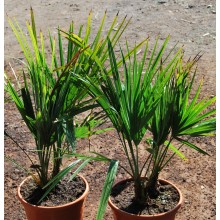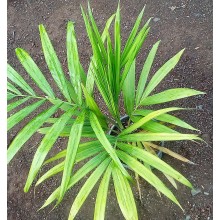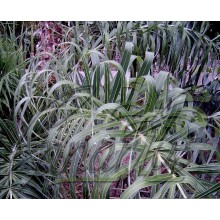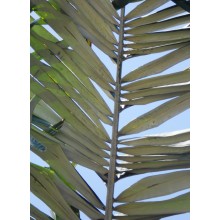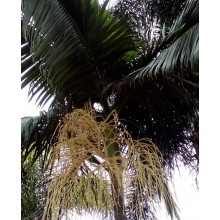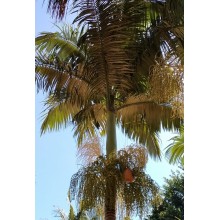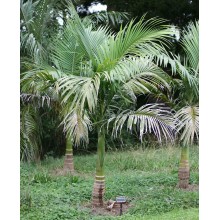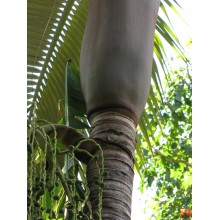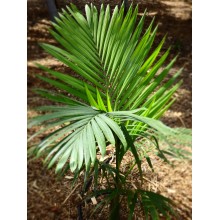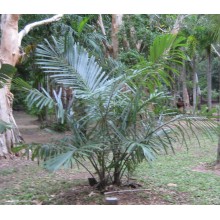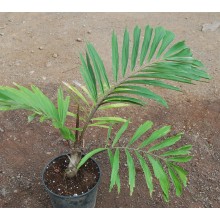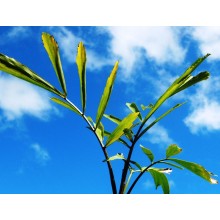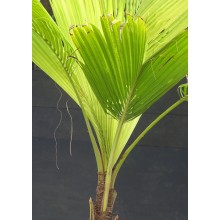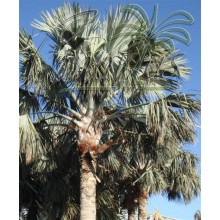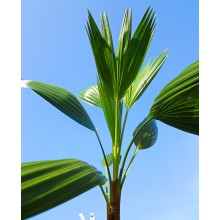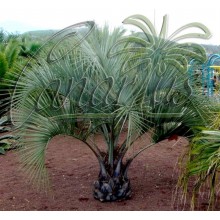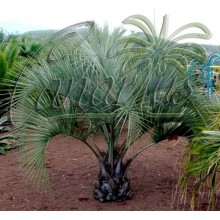Palmeras Hay 101 productos.

La familia de las palmeras, Arecaceae o Palmae, incluye cerca de 2.400 especies, nativas de climas cálidos del mundo, que van desde las delicadas especies tropicales a las palmeras resistentes al frío. Algunas palmas se pueden plantar al aire libre en Europa Central y aguantan fuertes heladas, muy por debajo de los -10 ºC (14 F). Los residentes en los países mediterráneos pueden cultivar un mayor número de especies en el exterior. Algunos cultivadores en la costa sur de Europa están criando colecciones de palmeras al aire libre que incluyen más de 100 especies.
Canarius sólo le enviará palmeras robustas, que se cultivaron en macetas pequeñas para reducir los costos de envío y problemas de preparación. Por ello, trasplántelas a macetas más grandes poco después de recibir el paquete. Esté preparado para darles lo mejor. Algunas palmeras pueden resistir nevadas, algunas pueden vivir en el interior o en macetas, y algunas son muy tropicales. Sólo tiene que elegir una que pueda prosperar en sus condiciones.
¿Qué palmeras pueden crecer en su área? Lea nuestra lista de palmeras resistente al frío para Europa. Visite el blog de Canarius y aprenda más acerca de nuestras palmeras. Verá fotos de los viveros: diferentes tipos de palmeras de Nueva Zelanda, Palmas botella con raíces de calidad superior.
-
Acoelorraphe wrightii
Acoelorraphe wrightii
This clumping palm is typically found in marshlands, with thin trunks up to 7 m tall. It is a symbol of the Everglades in Florida. Acoelorraphe tolerates brackish water and often grows with mangroves.
72,00 € -
Adonidia merrillii LARGE
Adonidia merrillii LARGE
This mid sized palm is popular in tropical gardens throughout the world.
49,30 € -
Allagoptera arenaria
Allagoptera arenaria
h= 20-40 cm - Cont. 16 cm. Low trunkless feather palm from the coastal dunes of Brasil, with elegant ruffled leaves coming out of the ground. Flowers are borne on unbranched spikes.Allagoptera needs drained sandy soil, enjoys coastal locations and can take light freezes. It can grow outdoors in coastal Mediterranean gardens.
27,60 € -
Allagoptera caudescens
Allagoptera caudescens
Elegant palm from Brazil. Leaves, are pinnate, with "clustered segments", silvery white underneath. It is slow but the beauty of the leaves starts soon! Flowers and fruits are produced on a large hanging spikes. It has some tolerance to cold, it takes short light frosts and can be tried outdoors in the coastal Mediterranean. It was formerly named...
31,40 € -
Archontophoenix maxima
Archontophoenix maxima
Very elegant palm from Australia, with slender ringet trunk, topped by a showy bright green crownshaft.
32,50 € -
Archontophoenix myolaensis
Archontophoenix myolaensis
This species of Archontophoenix is native to a small area in the mountainous region west of Cairns in N.W. Queensland, found in a few locations in gallery forests following rivers. It is similar to the more common Archontophoenix cunninghamiana, with a slightly smaller size, a bluer crownshaft and some other minor differences.
42,00 € -
Archontophoenix purpurea
Archontophoenix purpurea
The showy, colourful crownshaft is the masterpiece of this elegant solitary palm from australia. A rainbow of purple, green and blue.
52,00 € -
Archontophoenix tuckeri
Archontophoenix tuckeri
Uncommon Archontophoenix species from Northern Australia. Leaves are silver underneath, somewhat pendulous or drooping. It is suited to coastal Mediterranean condition and it takes cool weather and short, light frosts.
28,60 € -
Areca catechu
Areca catechu
Areca catechu is a species of palm native to the Philippines cultivated for areca nuts. Medium-sized palm tree, growing straight to 20 m tall, with a trunk 10–15 cm in diameter. The leaves are 1.5–2 m long, pinnate, with numerous, crowded leaflets.
29,40 € -
Arenga australasica
Arenga australasica
Clumping feather palm from NE Australia, found mainly in coastal areas. Despite its tropical origin, it grows in colder climates.
72,00 € -
Arenga engleri
Arenga engleri
Clumping frost-hardy palm with attractive pinnate leaves that are dark green above, and silver below. This tropical-looking palm is native to the open forests of Taiwan and the Ryukyu Islands.
51,00 € -
Arenga pinnata
Arenga pinnata
Arenga pinnata is an economically significant feather palm native to tropical Asia, ranging from eastern India to Malaysia, Indonesia, and the Philippines in the east.
48,30 € -
Arenga ryukyuensis
Arenga ryukyuensis
This new palm was described in from southern Ryukyu Islands of Japan. It is similar to the beautiful Arenga engleri from Taiwan but it is probably more cold-tolerant. It is also smaller, with shorter and thicker stems, to 2m and 20cm diameter, and leaves to just 2m long. Slow, but frost-resistant, to about -7 C!
36,60 € -
Beccariophoenix fenestralis
Beccariophoenix fenestralis
Beccariophoenix fenestralis is a spectacular, massive and rare Coconut relative from Magagascar.It is an imposing palm tree that is is cultivable in tropical and humid subtropical climate regions, in full sun and on rich soils, preferably sandy, acidic or neutral, where it grows quickly and vigorously.We offer a 60 cm high plant.
92,00 € -
Beccariophoenix fenestralis Large
Beccariophoenix fenestralis Large
Beccariophoenix fenestralis is a spectacular, massive and rare Coconut relative from Magagascar.It is an imposing palm tree that is is cultivable in tropical and humid subtropical climate regions, in full sun and on rich soils, preferably sandy, acidic or neutral, where it grows quickly and vigorously.We offer a 100 cm high plant.
132,00 € -
Bismarckia nobilis
Bismarckia nobilis
Majestic, "noble", silvery-blue palm native to the savannas of Madagascar. Fast growing large robust palm with fan-shaped leaves.
43,50 € -
Brahea edulis
Brahea edulis
This palm is native to the mountains of the small island of Guadalupe, off of the Western coast of Mexico. It is really endangered in habitat but it thrives in cultivation under a wide range of conditions. A perfect species for the Mediterranean.
26,00 € -
Butia odorata - Jelly Palm
Butia odorata - Jelly Palm
Feather palm with sweet, tasty, scented fruits. It is native to Brazil, Uruguay and Argentina and it is the only frost-hardy species of palm that can produce abundant, delicious and useful fruits in colder climates. Leaves are blue-silvery, elegantly arching. Mature specimens show no damage at -10 C and some have survived to -20 C !
43,50 € -
Butia odorata - Jelly Palm - Large
Butia odorata - Jelly Palm - Large
Feather palm with sweet, tasty, scented fruits. It is native to Brazil, Uruguay and Argentina and it is the only frost-hardy species of palm that can produce abundant, delicious and useful fruits in colder climates. Leaves are blue-silvery, elegantly arching. Mature specimens show no damage at -10 C and some have survived to -20 C !
159,00 €
En estos momentos tenemos pocos productos en esta categoría Palmeras
















